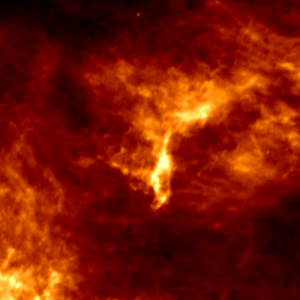
A low-density dusty structure in Pyxis, seen in the Planck 350 µm map of total intensity. The region shown is 10° x 10°.
BLAST-TNG’s improved resolution, sensitivity, and mapping speed will allow it to make detailed measurements of polarized emission from the dusty ISM in regions far more diffuse than has been possible in the past. Using the polarization position angle as a tracer of the plane-of-sky projection of the interstellar magnetic field, we will be able to study the dynamical influence of magnetic fields on ISM density structures. This will include comparisons with numerical models of MHD turbulence. BLAST-TNG will enable us to probe the properties of the ISM at the earliest stages of star-formation, in the transition from the atomic to molecular phase.
Furthermore, BLAST-TNG will provide the opportunity to study the dust itself in the diffuse ISM. The polarization signal from magnetically aligned dust has been shown to be a sensitive tracer of dust grain properties and the mechanisms that cause them to become aligned. We will be able to investigate grain alignment across a wide range of ISM environments and use this to place strong constraints on physical models of dust populations. Ultimately this will lead us to a better understanding of the conditions for which a measured polarization signal can be used as a proxy for tracing magnetic fields.




